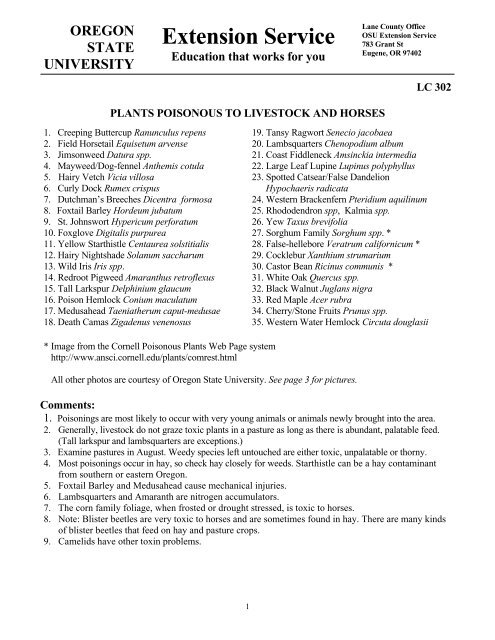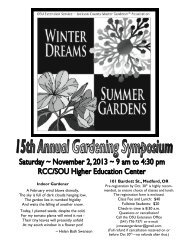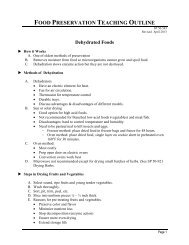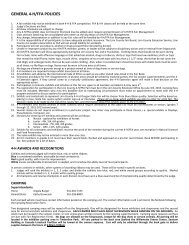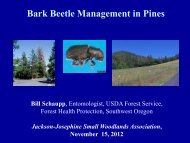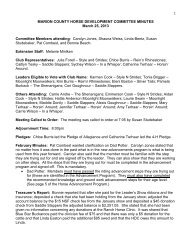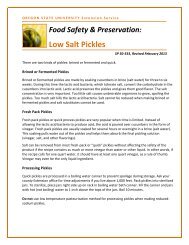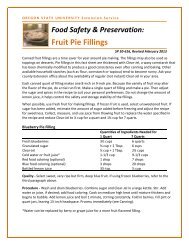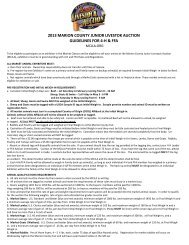pdf - Oregon State University Extension Service
pdf - Oregon State University Extension Service
pdf - Oregon State University Extension Service
Create successful ePaper yourself
Turn your PDF publications into a flip-book with our unique Google optimized e-Paper software.
OREGON<br />
STATE<br />
UNIVERSITY<br />
<strong>Extension</strong> <strong>Service</strong><br />
Education that works for you<br />
Lane County Office<br />
OSU <strong>Extension</strong> <strong>Service</strong><br />
783 Grant St<br />
Eugene, OR 97402<br />
LC 302<br />
PLANTS POISONOUS TO LIVESTOCK AND HORSES<br />
1. Creeping Buttercup Ranunculus repens 19. Tansy Ragwort Senecio jacobaea<br />
2. Field Horsetail Equisetum arvense 20. Lambsquarters Chenopodium album<br />
3. Jimsonweed Datura spp. 21. Coast Fiddleneck Amsinckia intermedia<br />
4. Mayweed/Dog-fennel Anthemis cotula 22. Large Leaf Lupine Lupinus polyphyllus<br />
5. Hairy Vetch Vicia villosa<br />
6. Curly Dock Rumex crispus<br />
23. Spotted Catsear/False Dandelion<br />
Hypochaeris radicata<br />
7. Dutchman’s Breeches Dicentra formosa 24. Western Brackenfern Pteridium aquilinum<br />
8. Foxtail Barley Hordeum jubatum 25. Rhododendron spp, Kalmia spp.<br />
9. St. Johnswort Hypericum perforatum 26. Yew Taxus brevifolia<br />
10. Foxglove Digitalis purpurea 27. Sorghum Family Sorghum spp. *<br />
11. Yellow Starthistle Centaurea solstitialis 28. False-hellebore Veratrum californicum *<br />
12. Hairy Nightshade Solanum saccharum 29. Cocklebur Xanthium strumarium<br />
13. Wild Iris Iris spp. 30. Castor Bean Ricinus communis *<br />
14. Redroot Pigweed Amaranthus retroflexus 31. White Oak Quercus spp.<br />
15. Tall Larkspur Delphinium glaucum 32. Black Walnut Juglans nigra<br />
16. Poison Hemlock Conium maculatum 33. Red Maple Acer rubra<br />
17. Medusahead Taeniatherum caput-medusae 34. Cherry/Stone Fruits Prunus spp.<br />
18. Death Camas Zigadenus venenosus 35. Western Water Hemlock Circuta douglasii<br />
* Image from the Cornell Poisonous Plants Web Page system<br />
http://www.ansci.cornell.edu/plants/comrest.html<br />
All other photos are courtesy of <strong>Oregon</strong> <strong>State</strong> <strong>University</strong>. See page 3 for pictures.<br />
Comments:<br />
1. Poisonings are most likely to occur with very young animals or animals newly brought into the area.<br />
2. Generally, livestock do not graze toxic plants in a pasture as long as there is abundant, palatable feed.<br />
(Tall larkspur and lambsquarters are exceptions.)<br />
3. Examine pastures in August. Weedy species left untouched are either toxic, unpalatable or thorny.<br />
4. Most poisonings occur in hay, so check hay closely for weeds. Starthistle can be a hay contaminant<br />
from southern or eastern <strong>Oregon</strong>.<br />
5. Foxtail Barley and Medusahead cause mechanical injuries.<br />
6. Lambsquarters and Amaranth are nitrogen accumulators.<br />
7. The corn family foliage, when frosted or drought stressed, is toxic to horses.<br />
8. Note: Blister beetles are very toxic to horses and are sometimes found in hay. There are many kinds<br />
of blister beetles that feed on hay and pasture crops.<br />
9. Camelids have other toxin problems.<br />
1
There are many poisonous plants that may be toxic to livestock and horses that are not referenced on this list.<br />
Do not assume a plant is not toxic just because it is not listed here.<br />
This material is provided as information only and is not to be used for the home treatment of animals. Please<br />
contact your veterinarian or poison control if poisoning is suspected.<br />
For further information, the Cornell <strong>University</strong> website contains many links to information on poisonous<br />
plants, http://www.ansci.cornell.edu/plants/comrest.html<br />
Authors: Ross Penhallegon, Pat Patterson, Larry Campbell, Pete Schreder<br />
OSU/Lane County <strong>Extension</strong> <strong>Service</strong><br />
Revised March 2002<br />
LCE Pubs/2000/LC 302 Plants Poisonous to Livestock for OSU<br />
© 2000 <strong>Oregon</strong> <strong>State</strong> <strong>University</strong>. This publication may be photocopied or reprinted in its entirety for noncommercial purposes. Produced and<br />
distributed in furtherance of the acts of Congress of May 8 and June 30, 1914. <strong>Extension</strong> work is a cooperative program of <strong>Oregon</strong> <strong>State</strong> <strong>University</strong>,<br />
the <strong>State</strong> <strong>University</strong>, the U.S. Department of Agriculture, and <strong>Oregon</strong> counties. <strong>Oregon</strong> <strong>State</strong> <strong>University</strong> <strong>Extension</strong> <strong>Service</strong> offers educational<br />
programs, activities, and materials--without regard to race, color, religion national origin, sex, sexual orientation, age, marital status, disability, and<br />
disabled veteran or Vietnam-era veteran status--as required by Title VI of the Civil Rights Act of 1964, Title IX of the Education Amendments of<br />
1972, and Section 504 of the Rehabilitation Act of 1973. <strong>Oregon</strong> <strong>State</strong> <strong>University</strong> <strong>Extension</strong> <strong>Service</strong> is an Equal Opportunity Employer.<br />
2
1 2 3 4 5<br />
6 7 8 9 10<br />
11 12 13 14 15<br />
16 17 18 19 20<br />
21 22 23 24 25<br />
26 27 28 29 30<br />
31 32 33 34 35


